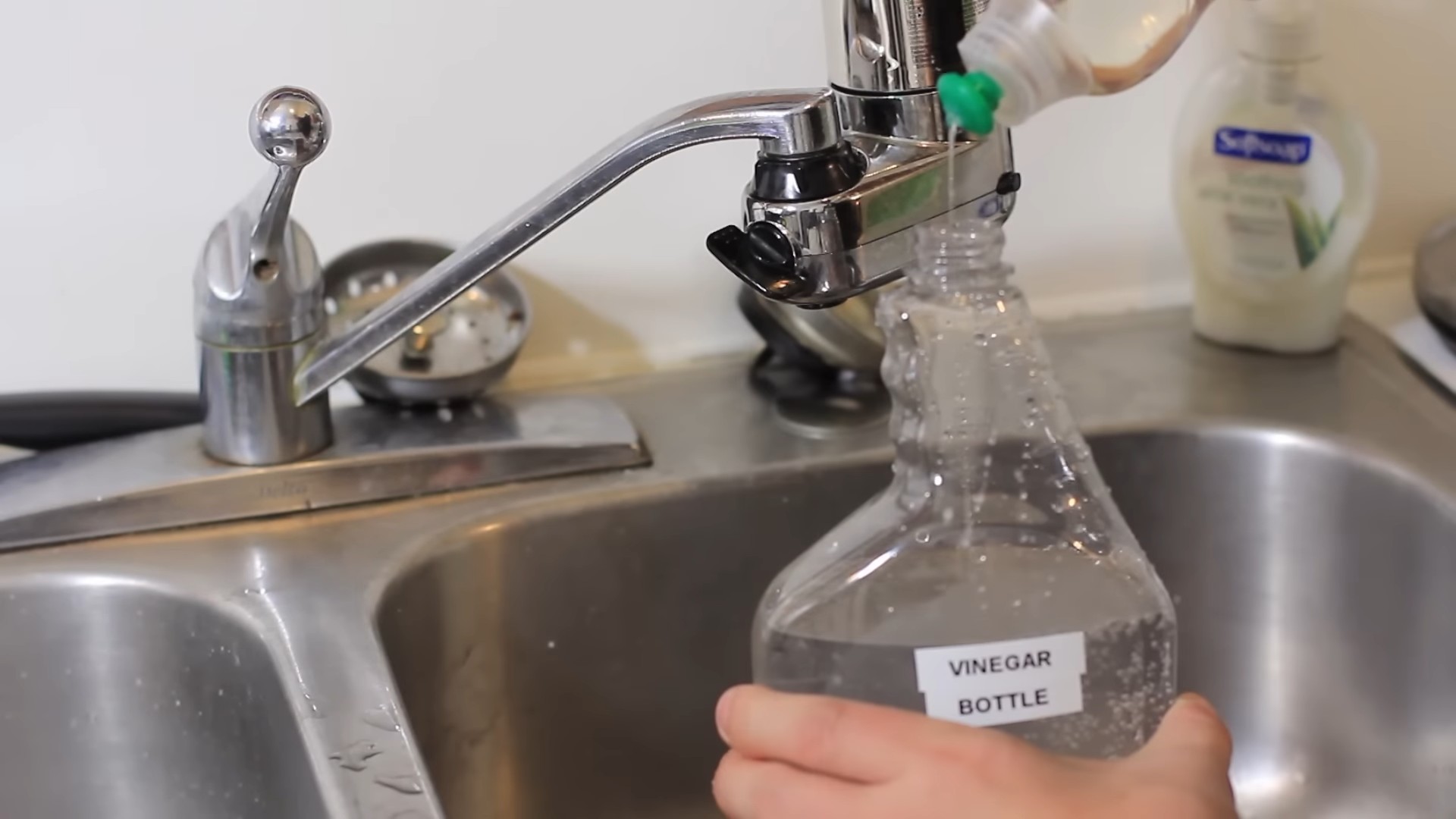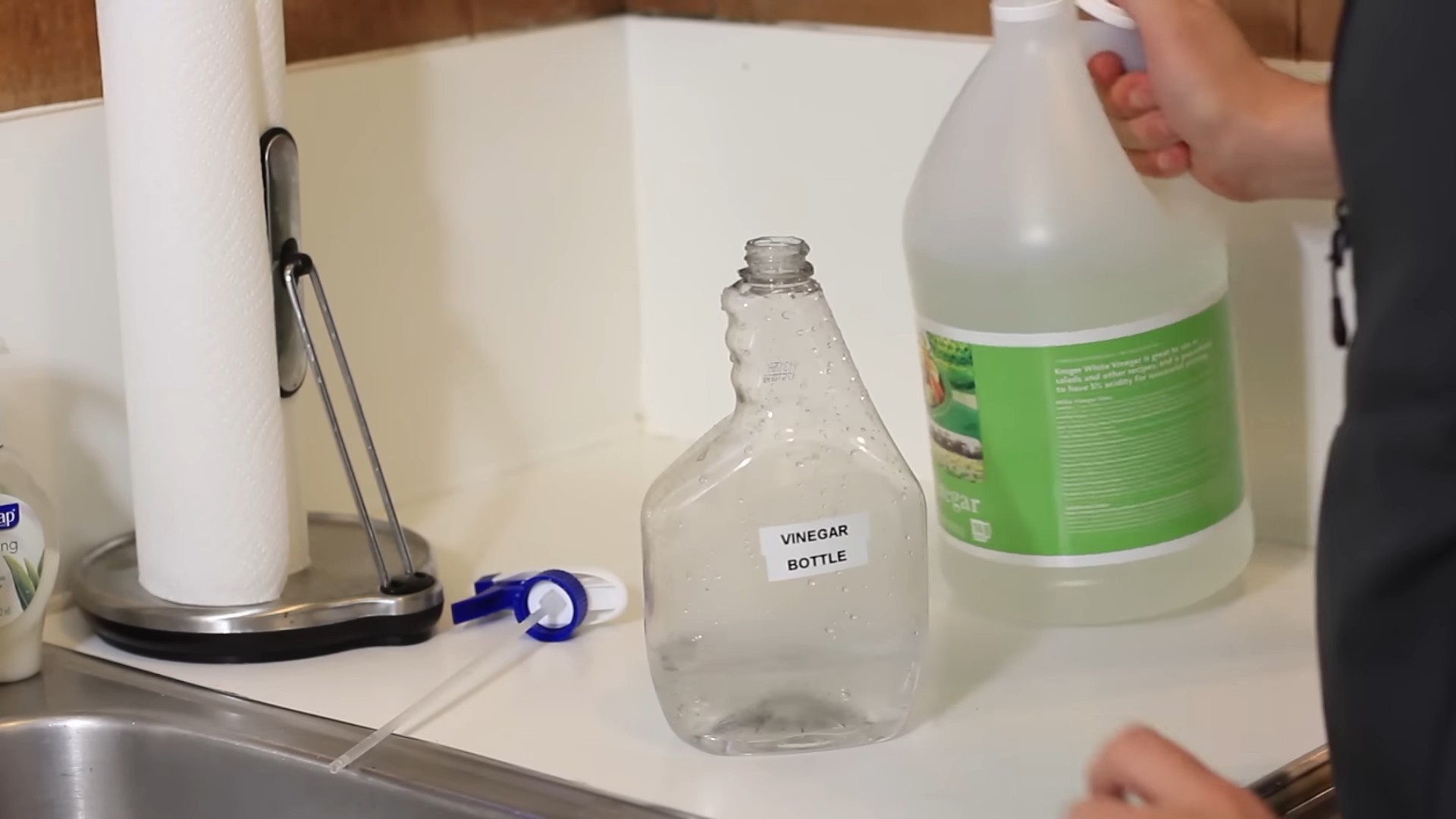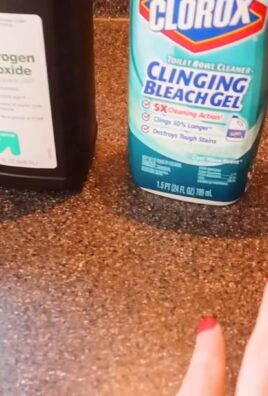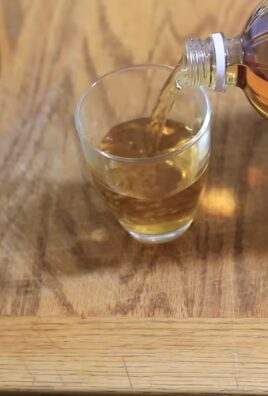Vinegar cleaning hacks are about to become your new best friend! Are you tired of spending a fortune on harsh chemical cleaners that promise the world but often leave you with lingering odors and a lighter wallet? I know I was! For generations, vinegar has been a staple in households, not just for cooking, but also for its incredible cleaning power. Think back to your grandmother’s cleaning rituals – chances are, vinegar played a starring role.
From ancient civilizations using it to preserve food to modern-day eco-conscious individuals embracing its versatility, vinegar has a rich history. But why is it so effective? The acetic acid in vinegar acts as a natural disinfectant and degreaser, making it a powerhouse against grime, mildew, and hard water stains.
This DIY article is packed with simple, effective, and budget-friendly vinegar cleaning hacks that will transform your cleaning routine. I’m going to show you how to tackle everything from stubborn bathroom buildup to sparkling windows, all with the help of this humble pantry staple. Get ready to ditch the expensive chemicals and embrace the natural cleaning power of vinegar – your home (and your wallet) will thank you!

Unlocking the Power of Vinegar: My Favorite DIY Cleaning Hacks
Vinegar! It’s not just for salad dressing anymore. This humble kitchen staple is a powerhouse when it comes to cleaning. I’ve been using vinegar for years to tackle all sorts of messes around my house, and I’m always amazed at how effective (and affordable!) it is. So, let me share some of my go-to vinegar cleaning hacks that will leave your home sparkling.
General Tips for Vinegar Cleaning
Before we dive into the specific hacks, here are a few general tips to keep in mind:
* Always use distilled white vinegar: This is the most common and versatile type of vinegar for cleaning. Avoid using other types of vinegar, like apple cider vinegar or balsamic vinegar, as they can stain surfaces.
* Dilute with water: Vinegar is acidic, so it’s best to dilute it with water to prevent damage to certain surfaces. A 1:1 ratio of vinegar to water is usually a good starting point.
* Test in an inconspicuous area: Before cleaning an entire surface with vinegar, test it in a small, hidden area to make sure it doesn’t cause any discoloration or damage.
* Ventilate the area: Vinegar has a strong odor, so make sure to open windows or turn on a fan when cleaning with it.
* Don’t mix with bleach: Mixing vinegar with bleach can create toxic fumes, so never combine these two cleaning agents.
Cleaning Your Kitchen with Vinegar
The kitchen is a breeding ground for germs and grime, but vinegar can help you keep it sparkling clean.
Cleaning the Microwave
My microwave gets pretty gross, pretty fast. Splatters everywhere! Here’s how I clean it with vinegar:
1. Prepare the vinegar solution: In a microwave-safe bowl, mix 1 cup of water with 1/4 cup of white vinegar.
2. Microwave the solution: Place the bowl in the microwave and heat it on high for 5-10 minutes, or until the solution boils and the microwave is filled with steam.
3. Let it sit: Leave the door closed for another 5-10 minutes to allow the steam to loosen any stuck-on food particles.
4. Wipe clean: Carefully remove the bowl (it will be hot!) and wipe down the inside of the microwave with a clean cloth or sponge. The grime should come off easily.
5. Dry: Dry the interior with a clean cloth.
Cleaning the Coffee Maker
A clean coffee maker means better-tasting coffee! Here’s how I descale mine with vinegar:
1. Prepare the vinegar solution: Fill the coffee maker’s water reservoir with a solution of equal parts white vinegar and water.
2. Run a brewing cycle: Turn on the coffee maker and let it run through a full brewing cycle.
3. Rinse with water: After the brewing cycle is complete, discard the vinegar solution and fill the reservoir with fresh water. Run two or three more brewing cycles with just water to rinse out any remaining vinegar.
4. Wipe down: Wipe down the exterior of the coffee maker with a damp cloth.
Cleaning the Dishwasher
Did you know you can clean your dishwasher with vinegar? It helps remove buildup and odors.
1. Remove debris: Make sure your dishwasher is empty and remove any large food particles from the bottom.
2. Place vinegar in a bowl: Place a dishwasher-safe bowl filled with 1 cup of white vinegar on the top rack of the dishwasher.
3. Run a hot cycle: Run the dishwasher on a hot cycle.
4. Repeat monthly: I try to do this once a month to keep my dishwasher running smoothly.
Cleaning Cutting Boards
Cutting boards can harbor bacteria, so it’s important to clean them thoroughly. Vinegar is a great natural disinfectant.
1. Rinse the cutting board: Rinse the cutting board with warm water.
2. Spray with vinegar: Spray the cutting board with undiluted white vinegar.
3. Let it sit: Let the vinegar sit on the cutting board for a few minutes.
4. Wipe clean: Wipe the cutting board clean with a damp cloth or sponge.
5. Rinse and dry: Rinse the cutting board with warm water and dry it thoroughly.
Cleaning Your Bathroom with Vinegar
The bathroom can be a tough place to clean, but vinegar can help you tackle soap scum, mildew, and hard water stains.
Cleaning Showerheads
Hard water can clog showerheads and reduce water pressure. Here’s how I clean mine with vinegar:
1. Prepare the vinegar solution: Fill a plastic bag with white vinegar.
2. Attach the bag to the showerhead: Secure the bag around the showerhead with a rubber band, making sure the showerhead is fully submerged in the vinegar.
3. Soak overnight: Let the showerhead soak in the vinegar overnight.
4. Remove the bag and rinse: Remove the bag and run the shower for a few minutes to flush out any remaining vinegar and debris.
5. Wipe clean: Wipe the showerhead clean with a cloth.
Cleaning Toilets
Vinegar can help remove stains and odors from your toilet.
1. Pour vinegar into the bowl: Pour 1-2 cups of white vinegar into the toilet bowl.
2. Let it sit: Let the vinegar sit in the bowl for at least 30 minutes, or preferably overnight.
3. Scrub and flush: Scrub the bowl with a toilet brush and flush.
4. Clean the exterior: Wipe down the exterior of the toilet with a solution of equal parts vinegar and water.
Cleaning Shower Doors
Soap scum can be a real pain to remove from shower doors. Vinegar to the rescue!
1. Prepare the vinegar solution: Mix equal parts white vinegar and warm water in a spray bottle.
2. Spray the shower doors: Spray the shower doors with the vinegar solution.
3. Let it sit: Let the solution sit on the shower doors for a few minutes.
4. Wipe clean: Wipe the shower doors clean with a sponge or cloth. For stubborn soap scum, you may need to scrub a little harder.
5. Rinse and dry: Rinse the shower doors with water and dry them with a squeegee or clean cloth.
Other Clever Vinegar Cleaning Hacks
Vinegar isn’t just for the kitchen and bathroom. Here are a few other clever ways I use it around my house:
Removing Stickers and Labels
Those pesky stickers and labels can be so hard to remove! Vinegar can help loosen the adhesive.
1. Soak the sticker: Soak the sticker or label with white vinegar.
2. Let it sit: Let the vinegar sit for a few minutes.
3. Peel it off: Gently peel off the sticker or label. If it’s still stuck, repeat the process.
4. Remove residue: Wipe away any remaining residue with a cloth dampened with vinegar.
Cleaning Windows and Mirrors
Vinegar can leave your windows and mirrors streak-free.
1. Prepare the vinegar solution: Mix equal parts white vinegar and water in a spray bottle.
2. Spray the surface: Spray the windows or mirrors with the vinegar solution.
3. Wipe clean: Wipe the surface clean with a microfiber cloth or paper towel.
Freshening Laundry
Vinegar can help remove odors and soften fabrics in your laundry.
1. Add vinegar to the wash: Add 1/2 cup of white vinegar to the washing machine during the rinse cycle.
2. Dry as usual: Dry your clothes as usual. Don’t worry, your clothes won’t smell like vinegar!
Cleaning Blinds
Cleaning blinds can be tedious, but vinegar can make it easier.
1. Prepare the vinegar solution: Mix equal parts white vinegar and water in a bowl.
2. Dip a cloth: Dip a clean cloth into the vinegar solution.
3. Wipe the blinds: Wring out the cloth and wipe each slat of the blinds.
4. Dry: Let the blinds air dry.
Reviving Dull Chrome Fixtures
Chrome fixtures can lose their shine over time. Vinegar can help restore their luster.
1. Apply vinegar: Dampen a cloth with white vinegar and wipe down the chrome fixtures.
2. Let it sit: Let the vinegar sit for a few minutes.
3. Rinse and dry: Rinse the fixtures with water and dry them with a clean cloth.
Removing Hard Water Stains from Faucets
Hard water stains can be unsightly on faucets. Vinegar can dissolve the mineral deposits.
1. Soak a cloth: Soak a cloth in white vinegar.
2.

Conclusion
So, there you have it! Unlocking the power of vinegar for cleaning is more than just a trend; it’s a sustainable, effective, and surprisingly versatile way to keep your home sparkling. We’ve explored how this humble kitchen staple can transform into a cleaning powerhouse, tackling everything from stubborn hard water stains to lingering odors. Why is this DIY trick a must-try? Because it’s economical, eco-friendly, and delivers impressive results without the harsh chemicals found in many commercial cleaners. You’re not just cleaning; you’re making a conscious choice for a healthier home and a healthier planet.
But the magic of vinegar doesn’t stop there. Feel free to experiment and adapt these techniques to suit your specific needs. For instance, if you find the vinegar scent a bit strong, infuse it with citrus peels (lemon, orange, or grapefruit work wonders!) for a naturally fragrant boost. Simply add the peels to a jar of vinegar and let it steep for a week or two before using. You can also add a few drops of your favorite essential oils, like lavender or tea tree, for their antibacterial and aromatic properties. Remember to always test any cleaning solution in an inconspicuous area first, especially on delicate surfaces.
Consider these variations to elevate your vinegar cleaning game:
* **Vinegar and Baking Soda Power Duo:** For clogged drains, pour 1/2 cup of baking soda down the drain, followed by 1 cup of vinegar. Let it fizz for 30 minutes, then flush with hot water. Repeat if necessary.
* **Vinegar as a Fabric Softener:** Add 1/2 cup of white vinegar to your washing machine’s fabric softener dispenser for softer, brighter clothes. It also helps remove detergent residue.
* **Vinegar for Sparkling Windows:** Mix equal parts white vinegar and water in a spray bottle for streak-free windows and mirrors.
* **Vinegar to Remove Stickers and Labels:** Soak a cloth in white vinegar and apply it to the sticker or label. Let it sit for a few minutes, then peel away the sticker.
We’ve armed you with the knowledge and the inspiration to embrace the world of **vinegar cleaning hacks**. Now, it’s your turn to put these tips into action. We are confident that you’ll be amazed by the cleaning power of vinegar and how it can simplify your cleaning routine.
Don’t just take our word for it – try these DIY tricks and see the difference for yourself! We encourage you to share your experiences, tips, and variations in the comments below. What are your favorite vinegar cleaning hacks? What challenges did you overcome? What unexpected successes did you discover? Your insights will not only help other readers but also contribute to a growing community of eco-conscious cleaners. Let’s unlock the full potential of vinegar together and create cleaner, healthier homes, one DIY trick at a time. We can’t wait to hear your stories!
Frequently Asked Questions (FAQs)
Is it safe to use vinegar on all surfaces?
No, it’s not. While vinegar is a fantastic cleaner for many surfaces, it’s acidic and can damage certain materials. Avoid using vinegar on natural stone surfaces like marble, granite, and limestone, as it can etch and dull the finish. It’s also best to avoid using vinegar on waxed wood, as it can strip the wax. Always test a small, inconspicuous area first before applying vinegar to a larger surface. If you’re unsure, consult the manufacturer’s instructions for the surface you’re cleaning.
What type of vinegar is best for cleaning?
White distilled vinegar is the best choice for cleaning. It’s clear, inexpensive, and has a relatively low acidity level (around 5%), making it safe for most cleaning applications. Avoid using other types of vinegar, such as apple cider vinegar or balsamic vinegar, as they can stain surfaces due to their color and sugar content. Cleaning vinegar is also available, which has a higher acidity level (around 6%) and is even more effective for tough cleaning jobs. However, use cleaning vinegar with caution and dilute it appropriately.
How do I get rid of the vinegar smell after cleaning?
The vinegar smell typically dissipates within a few hours. To speed up the process, open windows and doors to ventilate the area. You can also place a bowl of baking soda in the room to absorb odors. As mentioned earlier, infusing vinegar with citrus peels or adding essential oils can also help mask the scent. Another trick is to wipe down surfaces with a damp cloth and a few drops of your favorite essential oil after cleaning with vinegar.
Can I mix vinegar with bleach?
Absolutely not! Mixing vinegar with bleach creates chlorine gas, which is highly toxic and can be fatal. Never, ever mix these two substances. Always use vinegar and bleach separately, and rinse surfaces thoroughly with water after using either product. Safety should always be your top priority when cleaning.
How often should I clean with vinegar?
The frequency of cleaning with vinegar depends on your needs and preferences. For general cleaning, you can use vinegar once or twice a week. For tougher cleaning jobs, like removing hard water stains or unclogging drains, you may need to use vinegar more frequently. Pay attention to the cleanliness of your home and adjust your cleaning schedule accordingly.
Can vinegar kill mold?
Yes, vinegar can kill some types of mold. White distilled vinegar is about 80% effective in killing mold species. To kill mold with vinegar, spray undiluted vinegar onto the affected area and let it sit for an hour. Then, wipe the area clean with a damp cloth. For stubborn mold, you may need to repeat the process. However, it’s important to note that vinegar may not be effective against all types of mold, and it’s not a substitute for professional mold remediation in severe cases. If you have a large mold problem, it’s best to consult a professional.
Is vinegar safe for septic systems?
Yes, vinegar is generally safe for septic systems. It’s a natural and biodegradable substance that won’t harm the beneficial bacteria in your septic tank. In fact, vinegar can even help maintain a healthy septic system by breaking down grease and organic matter. However, it’s important to use vinegar in moderation and avoid pouring large amounts down the drain at once.
Can I use vinegar to clean my coffee maker?
Yes, you can use vinegar to clean your coffee maker. Fill the water reservoir with equal parts white vinegar and water. Run the coffee maker through a full brewing cycle. Then, run two cycles with fresh water to rinse away any remaining vinegar. This will help remove mineral buildup and keep your coffee maker functioning properly.
How do I clean my microwave with vinegar?
To clean your microwave with vinegar, mix 1 cup of water with 1/4 cup of white vinegar in a microwave-safe bowl. Microwave on high for 5 minutes. Let the bowl sit in the microwave for another 5 minutes without opening the door. The steam will loosen any food splatters, making them easy to wipe away with a cloth.
What are some other uses for vinegar besides cleaning?
Vinegar has many other uses besides cleaning, including:
* **Weed killer:** Spray undiluted vinegar on weeds to kill them.
* **Laundry booster:** Add 1/2 cup of vinegar to your laundry to brighten colors and remove odors.
* **Fruit fly trap:** Place a small bowl of vinegar with a few drops of dish soap near fruit flies to trap them.
* **Egg poaching:** Add a tablespoon of vinegar to the water when poaching eggs to help them hold their shape.
* **Sore throat remedy:** Gargle with a mixture of warm water and vinegar to soothe a sore throat.
These are just a few of the many uses for vinegar. With its versatility and affordability, vinegar is a must-have in every home. Remember to always research and use caution when trying new applications of vinegar.




Leave a Comment